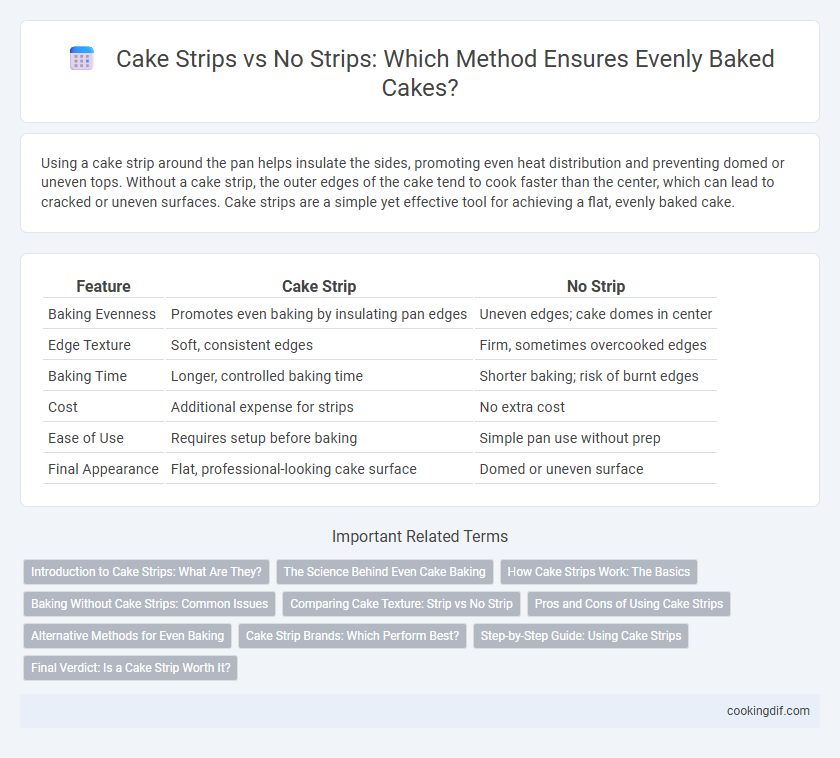Using a cake strip around the pan helps insulate the sides, promoting even heat distribution and preventing domed or uneven tops. Without a cake strip, the outer edges of the cake tend to cook faster than the center, which can lead to cracked or uneven surfaces. Cake strips are a simple yet effective tool for achieving a flat, evenly baked cake.
Table of Comparison
| Feature | Cake Strip | No Strip |
|---|---|---|
| Baking Evenness | Promotes even baking by insulating pan edges | Uneven edges; cake domes in center |
| Edge Texture | Soft, consistent edges | Firm, sometimes overcooked edges |
| Baking Time | Longer, controlled baking time | Shorter baking; risk of burnt edges |
| Cost | Additional expense for strips | No extra cost |
| Ease of Use | Requires setup before baking | Simple pan use without prep |
| Final Appearance | Flat, professional-looking cake surface | Domed or uneven surface |
Introduction to Cake Strips: What Are They?
Cake strips are fabric bands designed to wrap around cake pans to promote even baking by insulating the edges, preventing them from cooking faster than the center. These strips help reduce doming and cracking by maintaining a consistent temperature throughout the cake batter. Using cake strips results in a more level and uniformly baked cake, minimizing the need for excessive leveling or trimming.
The Science Behind Even Cake Baking
Cake strips promote even baking by insulating the cake pan's edges, which slows heat exposure and prevents domed or overcooked edges. Without strips, the pan edges heat faster, causing uneven rising and potential cracking due to temperature gradients. Using cake strips ensures uniform gelatinization and Maillard reactions, resulting in a flat, evenly baked cake surface.
How Cake Strips Work: The Basics
Cake strips work by insulating the outer edges of the cake pan, allowing heat to distribute more evenly and preventing the sides from baking faster than the center. These strips keep the batter cooler on the pan's edges, resulting in a uniformly risen cake without domed tops or cracked surfaces. Using cake strips ensures consistent texture and even baking, contrasting with no-strip methods that risk uneven cooking and irregular shapes.
Baking Without Cake Strips: Common Issues
Baking cakes without using cake strips often results in uneven heat distribution, causing domed or cracked tops and inconsistent baking. Without cake strips to insulate the pan edges, the cake sides cook faster than the center, leading to overbaked edges and underbaked interiors. This common issue compromises cake texture and appearance, emphasizing the importance of temperature regulation tools in baking.
Comparing Cake Texture: Strip vs No Strip
Cake strips promote even baking by insulating the pan's edges, which prevents doming and results in a uniformly flat cake with consistent crumb texture. Without cake strips, edges tend to bake faster, often creating a domed top and uneven crumb density between the center and sides. Using cake strips ensures smoother cake layers, ideal for stacking and decorating, by maintaining consistent moisture and texture throughout.
Pros and Cons of Using Cake Strips
Cake strips promote even baking by insulating the cake pan, preventing over-browned edges and domed tops, leading to a uniformly flat cake surface ideal for layering. However, they require extra preparation time and additional materials, which can be inconvenient for quick baking sessions. Without cake strips, cakes may bake unevenly with domed or cracked tops, but the process is faster and simpler, suitable for less precision-focused baking.
Alternative Methods for Even Baking
Cake strip vs no strip methods impact temperature control and even baking by affecting heat distribution along pan edges; cake strips insulate pans to slow edge baking, preventing domed centers and promoting uniform rise. Without strips, alternative techniques include lowering oven temperature, using an oven-safe core or flower nail in the pan center, or baking in a water bath to moderate heat exposure. These methods optimize crumb texture and structural integrity, ensuring consistent doneness throughout the cake layers.
Cake Strip Brands: Which Perform Best?
Cake strips from brands like Wilton and Fat Daddio's consistently deliver more even baking by insulating the cake edges, preventing dome formation and promoting uniform heat distribution. While cheaper or generic strips may absorb moisture less efficiently, premium options made of cotton and silicone ensure optimal hydration and thermal regulation, resulting in flatter, more professional layers. Reviews and baking tests reveal Fat Daddio's cake strips excel in durability and watertight performance, making them the preferred choice among cake decorators seeking precision and reliability.
Step-by-Step Guide: Using Cake Strips
Cake strips evenly insulate the sides of cake pans, preventing domed tops and promoting level layers by slowing the baking process around the edges. To use cake strips, soak them in cold water for 15-20 minutes, wring out excess water, then wrap securely around the cake pan, fastening with pins or Velcro to ensure full coverage. Baking with cake strips requires slightly longer baking time and cooler oven temperature settings to achieve even heat distribution and perfectly flat cake layers.
Final Verdict: Is a Cake Strip Worth It?
Cake strips ensure even baking by insulating the edges and preventing domed or cracked tops, resulting in a flat, professional finish. Bakers seeking consistent layers and precise cake assembly often find cake strips worth the minimal investment in time and cost. Without strips, uneven heat distribution can cause rising problems and uneven texture, impacting both appearance and structural integrity.
Cake Strip vs No Strip for even baking Infographic

 cookingdif.com
cookingdif.com